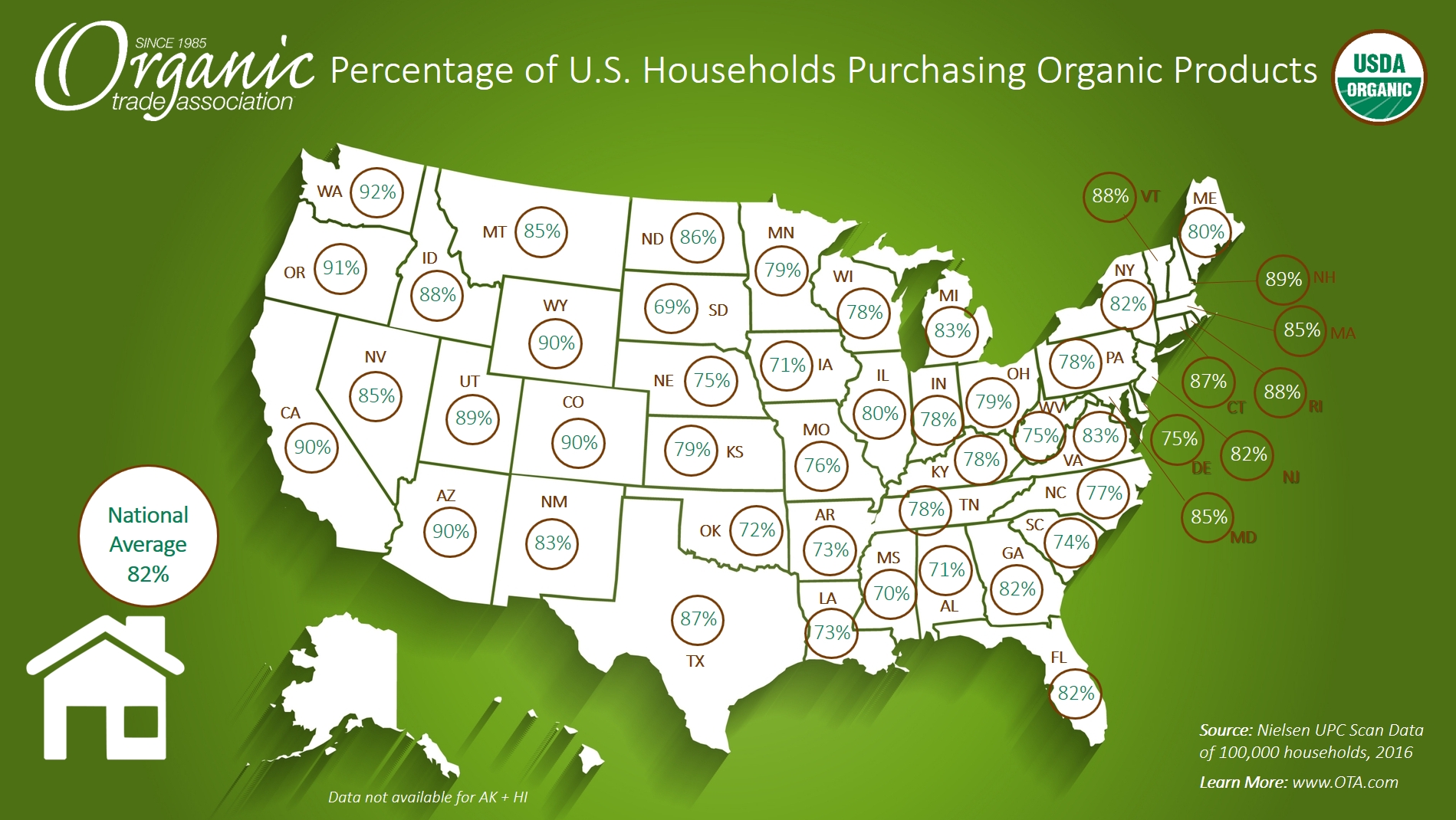OTA releases state-by-state data showing more households – urban and rural -- choosing organic
As former Georgia Governor Sonny Perdue begins his confirmation process to become the next Secretary of Agriculture, new Nielsen findings released by the Organic Trade Association (OTA) on Thursday show things have changed in the kitchens of American households across the country, from small towns to the big cities. Organic can now be found on the shelves of kitchen cupboards and in the refrigerators of 82.3 percent of American households, including in the majority of households in rural states like Perdue’s home state of Georgia.
In the first comprehensive look at organic purchases by households on a state-by-state level, the nationally representative Nielsen study of 100,000 households conducted in 2015 and 2016 reported that more households than ever bought organic food on a regular basis throughout 2016. The national average climbed 3.4 percent from 2015 to 82.3 percent, while in Georgia, the number of households buying organic rose by a solid 4 percent to 81.5 percent. The state showing the biggest jump in households purchasing organic was North Dakota, where 85.6 percent of households participating in the Nielsen study reported buying organic in 2016, up a robust 14.2 percent from 2015.
“These new findings show how important organic has become to millions and millions of American families everywhere – to more than 80 percent of our nation’s 117 million households*, more than 80 percent of Georgia’s 3.5 million* households, more than 85 percent of North Dakota’s almost 300,000 households*,” said Laura Batcha, CEO and Executive Director of OTA. “The organic community is looking forward to working with the new leadership at USDA. We are eager to show how important adequate funding is to support a strong organic program and to help organic to continue to become a part of healthy diets of households throughout our nation – including Mr. Perdue’s home state and rural states from coast to coast.”
The Nielsen findings show a number of states in which 90 percent or more of households now buy organic on a regular basis, with even the lowest levels all hovering around 70 percent. The five states seeing the biggest increases in households reporting organic purchases were:
- North Dakota, where 85.6 percent of households participating bought organic in 2016, up 14.2 percent from 2015;
- Rhode Island, with 88.3 percent buying organic, up 12.3 percent from 2015;
- Wyoming, where 90.0 percent of participating households bought organic in 2016, up 10.8 percent;
- South Dakota, which had the lowest percentage of any state at 68.9 percent, but still recorded a 10.0 percent increase;
- Wisconsin, where 77.6 percent of participating households bought organic, up 9.1 percent from 2015.
“Organic provides a healthy choice for consumers everywhere, and a profitable choice for farmers,” said Batcha. “The industry relies on a few critical public institutions to support this burgeoning industry, including the National Organic Program for global oversight and uniform standards and research investment targeted to organic production. Organic is fueled by consumers, and it thrives when USDA recognizes the importance of organic to rural economies and to rural households.”
In Georgia, a partnership between the Georgia Department of Agriculture and the non-profit group Georgia Organics has shown how investment into helping farmers wanting to go organic can make a difference.
“Georgia is becoming a bigger player in meeting the growing consumer demand for organics, thanks to innovative farmers, entrepreneurs, and excellent partners,” said Georgia Organics Executive Director Alice Rolls. “Georgia Agriculture Commissioner Gary Black has partnered with Georgia Organics on our 200 Organic Farms campaign to double the number of organic farms by 2020. His relationship with Sonny Perdue no doubt will be influential on a number of fronts, including organic agriculture.”
Organic food sales in the United States now total around $40 billion annually, and account for around five percent of total food sales in this country. According to the Organic Trade Association’s 2016 U.S. Organic Industry Survey, total organic food sales in 2015 were $39.7 billion, up 11 percent from the previous year. This spring OTA will be releasing its 2017 industry survey, which will look at the U.S. organic market in 2016.
The Nielsen data comes from 100,000 participating households in the 48 contiguous states that are geographically and demographically diverse to represent the national population. Participating households record with a home scanner all food purchases for in-home consumption from any retail outlet, including organic items. Participants scan the Universal Product Codes (the bar codes that cashiers scan at the supermarket) to track their purchases. Nielsen has been tracking food purchases with its home scanner household panel since 2002.
*According to the most recent U.S. Census Bureau statistics
The Organic Trade Association (OTA) is the membership-based business association for organic agriculture and products in North America. OTA is the leading voice for the organic trade in the United States, representing over 9,500 organic businesses across 50 states. Its members include growers, shippers, processors, certifiers, farmers' associations, distributors, importers, exporters, consultants, retailers and others. OTA’s Board of Directors is democratically elected by its members. OTA's mission is to promote and protect ORGANIC with a unifying voice that serves and engages its diverse members from farm to marketplace.

